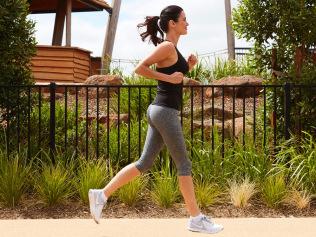Expert tips to training for a fun run
If you’re looking to get fitter and healthier this year, the best thing to do is pick a goal and then work backwards.

If you’re looking to get fitter and healthier this year, the best thing to do is pick a goal and then work backwards.
If you’re starting from the couch, the idea of “getting fit” can be overwhelming. The goal is too big and too vague, and there aren’t any defined milestones you can celebrate along the way.
Set yourself a goal
According to expert trainer Sam Wood, who runs the 28 by Sam Wood program, fun runs - like Run for the Kids - can be an excellent source of motivation if you’re building up from a low or medium level of fitness.
“I always advise that you start at the end and work your way back, so you reverse-engineer a program based on how far you have to run, how long you have to train for it, and what base you’re starting at,” he says.
“You’ve got to be able to complete a run of the same distance as the run you’ve booked yourself in for at least a week before the actual date. That’s to both physically and mentally show yourself you can do it.”
He says fun runs are a brilliant source of motivation - even though the idea of paying to do a run with a bunch of random other people might feel a bit strange the first time you do it. He’s actually planning to do Run for the Kids himself because he and a friend made a pact to do it together.
“We’re not going to break any land speed records or anything like that,” he laughs.
“It’s brilliant. People say it’s so weird they’re paying to do a run, but I don’t know anyone who doesn’t run one without understanding why. It’s the exhilaration of running in a crowd, you just get swept up in the euphoria of it all.”
The key is to make sure you’ve got enough time to train.
So how do you actually start out?
Olivia Scalzo is a group fitness instructor at Woodlea, and says the most important thing people can do when they’re just starting out is to set themselves small goals.
“You need to find things you can actually tick off, because reaching those small goals will help keep you motivated.”
She said the best way to grow those small goals into something larger is to find ways to keep you motivated.
“Some people join a walking group or find a training buddy. You could also join local training sessions designed to help you achieve your goals. For example I’m running a six week training program that anyone can join. It’s family friendly and all fitness levels can join.”
Ms Scalzo believes it’s important to mix up your training to both push your body, and also stop you from getting bored.
“At local parks in Woodlea, there’s free gym equipment you can use. That’s a great way to mix up your training.”
She said it’s important to not slip back into old habits when you’re training towards your goal.
“I’d recommend training at least every second day – probably four or five times a week. That doesn’t mean you have to run every day – mix it up. You can try gym sessions, long walks, or just running your local streets.”
Keeping it interesting
Running the same old track around your suburb can only keep you motivated for so long, so it’s important to mix up your training to keep your mind engaged. This could mean exploring a local park or a new suburb, or even running on a treadmill every so often while watching an episode of your favourite show.
Melbourne is fortunate to have some great tracks. For example, if marked running tracks are your thing, there’s a new 5km running track in Woodlea - you can time each lap to monitor your progress. If it’s a hot day, you could run through the streets of Williamstown and cool off with a quick dip at the beach. If you’d like to try something more adventurous, you could try trail running in Werribee Gorge.
Running should be fun, and you should reward yourself for getting outside and doing it. Ms Scalzo also said if your motivation is waning, bring in your pets or kids: they’ll help push you along (even if you’re pushing them in a pram!).
“If you have a pet, run with them. Walk with your kids, or anyone else you can find to keep you motivated.”
Fuelling yourself for success
The final piece of the puzzle is eating well, so your body has the energy it needs to run.
Caitlin Reid, a dietician from Health and the City, says in the weeks leading up to the race it’s important to make sure you focus on recovery and eat foods that will help repair your muscles.
“Make sure your post-training meals include protein to rebuild and repair muscle, carbohydrates to refuel and fluid to rehydrate. The better you recover, the more prepared you’ll be for your next training session,” she says.
As a general rule you’ll need about 20 grams of protein and 1 gram of carbohydrates per kilogram body weight. Basically, 30 grams of carbs is equivalent to two slices of bread, two pieces of fruit or a tub of fruit-flavoured yoghurt, so these are probably good items to stock-up on.
Before each run, you should top up your energy levels.
“The meal needs to be high carbohydrate (think oats, rice, bread, fruit, sweet potato), moderate protein (meat, chicken, fish, eggs, dairy products) and low fat and fibre,” she says.
“The pre-training meal should be three or four hours before training or competing, with a lighter meal or snack one or two hours before training or competing.”
Enjoy the race
The Herald Sun/Transurban Run for the Kids raises money for the Royal Children’s Hospital Good Friday Appeal. The event starts and finishes in the Docklands, and this year, it will be held on Sunday April 7. There is a long course option of 12.8km or a short course option of 5.2km sponsored by Woodlea.
Originally published as Expert tips to training for a fun run


